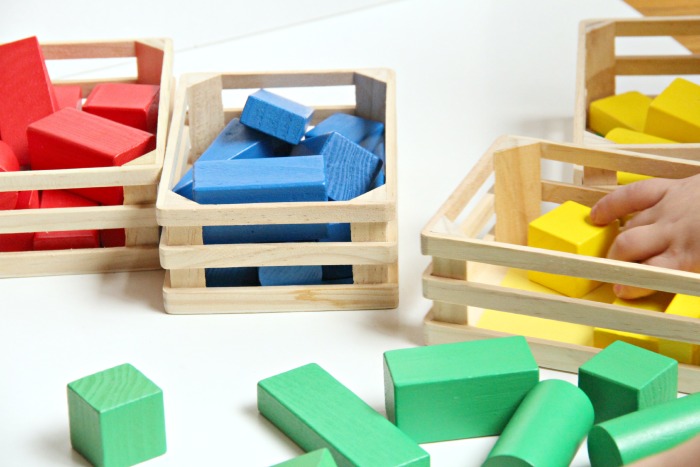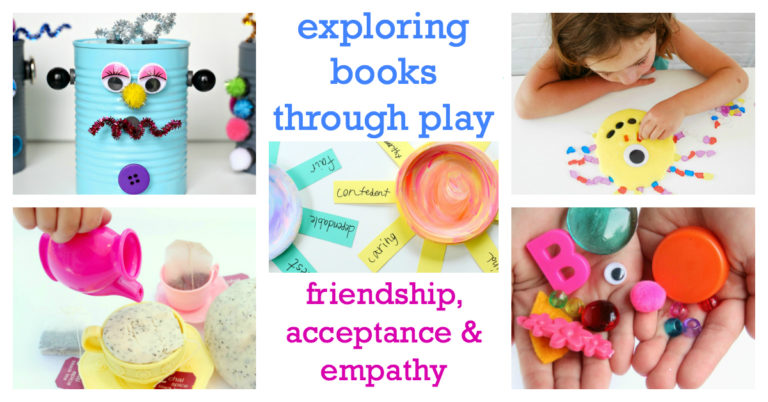A feelings check in station in the classroom is a great way to explore emotions and develop the emotional regulation strategies to support social emotional development. The block activity that we share below is one feelings check in that can be used with preschoolers or young kids in a kindergarten classroom, but with some adaptations, this can work for older children as well.
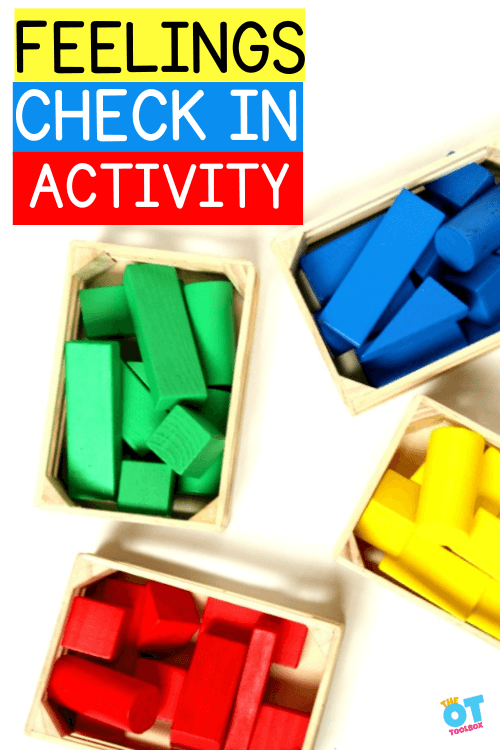
Feelings Check In
There is more to checking in with feelings than just identifying and naming emotions. Developing an emotional vocabulary is part of the social emotional learning that kids need.
Our emotions play dough mats are another fun tool to use in an emotions check in.
We created this feelings check in activity many years ago, using colored blocks and labelled bins or baskets. We love this activity for learning the colors that go along with the Zones of Regulation® program.
This feeling checking in activity is a great social emotional activity for preschoolers.
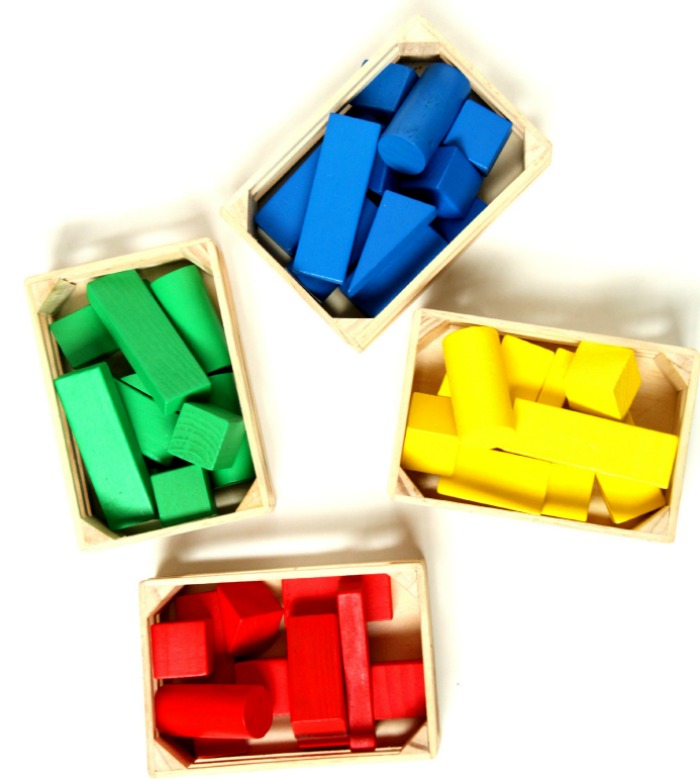
This color sorting busy bag activity allows children to sort colored blocks while working on color identification, shape and identification with eye-hand coordination, fine motor skills, visual memory, and visual scanning.
For our feelings check-in activity, we used the colors red, blue, green, yellow because that was the colors of blocks that we had in our set. The fact that they matched the Zones of Regulation colors was actually coincidental. It was a great teaching moment for identifying those colors and the associated states of regulation, however. You could substitute different colors if needed. Or, you could use plain blocks labeled with emotion names. Using these colors that are associated with various feeling names is convenient, however.
Supplies needed for this emotions check in activity:
- Four containers or wooden crates
- Colored blocks in four different colors (You could also substitute the colored blocks with colored craft sticks or plain blocks/pieces of paper labelled with feeling names)
- Colored paper to match the colors of the blocks
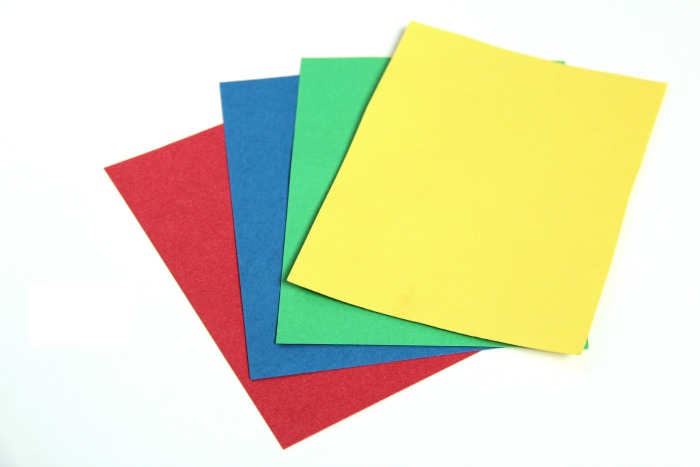
Set up the emotions check in activity:
- Start by cutting the paper to fit your containers. Label the paper with names of emotions. We used wooden crates for our sorting activity, so rectangles fit the bottom of the crates worked. If you are using bowls, cut the paper into circles. You’ll want the base of the containers to hold the paper.
- You can also label the outside of the container if you like, or you can challenge the little ones to identify emotions and feelings based on the colors.
- Scatter the colored blocks around on the table and begin the sorting activity by showing the child how to sort the colored blocks into the containers. The child can select one block that matches their emotion or feelings and “check in” by placing the block into a container.
Looking around at the scattered blocks allows a child to work on their visual scanning. The child needs to scan and examine the surface with many colored blocks, while focusing and fixating their eyes on the specific colors. Another benefit of scanning for the name of the feeling that they are identifying with is that the child/student can see that there are many different emotions that they are not personally experiencing at that moment.
This supports the awareness of empathy as well as the development of empathy, and the awareness that others may not check in with the same emotion as them at that given moment.
Additionally, scanning for the block that they are looking for and the matching container color supports visual processing skills. This pattern of fixations and saccades of the eyes is a necessary organized skill required for tasks such as reading and writing.
Visual perceptual skills are closely related to eye-hand coordination. Eye-hand coordination, (or hand-eye coordination) is defined as using the hands in a coordinated manner in conjunction with the movements of the eyes. Visual input guides reaching and grasping of the hands in functional activities).
Encourage language in this activity by asking questions such as “What shape is this block?”, “What feeling does this color match?”, “What color goes into this crate?” Asking these questions develops an emotional vocabulary that will carry into other tasks throughout the day as a tool for supporting regulation.
Feelings Check in for Older Kids
This activity can be adjusted for older children by asking the child to count the number of blocks in each container, doing simple addition (“How many blocks are in the yellow bin and the green bin all together?”)
To make this more appropriate for older kids, you can replace blocks with tally marks or a paper that they slip into a ballot box (for privacy). Also, offer paper next to the check in. After they “check in their feelings”, they can write about it on a private journal. This is a great way to support emotional development with the middle school age range and a wonderful middle school journal prompt.
Asking older kids to come up with coping tools as needed can be helpful, too.
Other feelings check in activities include:
- Feelings paper plate crafts
- Emotions play dough mats
- Emotion memory card games
- Playing emotional regulation games
- Reading emotional regulation books
- Pumpkin emotion activities (substitute with other shapes and themes throughout the year)
If you liked this feelings activity, you’ll love the hands-on, play-based activities and crafts in our collaborative book, Exploring Books Through Play: Friendship, Acceptance & Empathy. The book is geared toward the preschool and young elementary age, and includes many activities to foster an awareness of feelings and the feelings of others.
Get the special discount pricing here.

Colleen Beck, OTR/L has been an occupational therapist since 2000, working in school-based, hand therapy, outpatient peds, EI, and SNF. Colleen created The OT Toolbox to inspire therapists, teachers, and parents with easy and fun tools to help children thrive. Read her story about going from an OT making $3/hour (after paying for kids’ childcare) to a full-time OT resource creator for millions of readers. Want to collaborate? Send an email to contact@theottoolbox.com.


